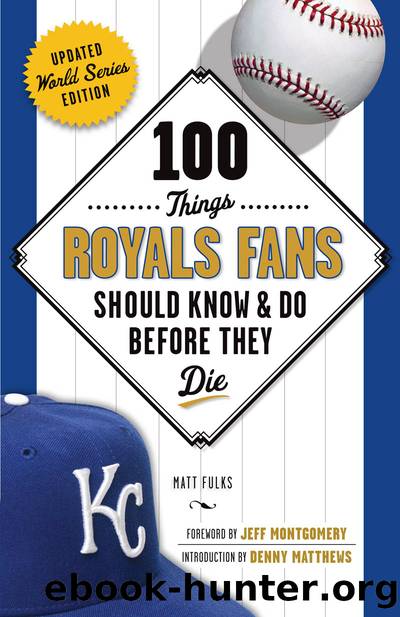100 Things Royals Fans Should Know & Do Before They Die by Matt Fulks

Author:Matt Fulks
Language: eng
Format: epub
Publisher: Triumph Books
Published: 2016-02-10T00:00:00+00:00
48. The Truman Sports Complex
Thereâs an artistâs rendering hanging in a back room of Chappellâs restaurant that shows a baseball stadium and a football stadium with a funny-looking half-moon structure between the two buildings. The caption reveals architect Charles Deatonâs idea for a rolling roof between what would become the Truman Sports ComplexâRoyals Stadium and Arrowhead.
Although the rolling roof never came to fruition, even the whole idea of two stadiums seemed preposterous. Throughout the 1960s in cities with Major League Baseball and NFL teams, multi-purpose or cookie-cutter stadiums were the rage. Stadiums were sought that could hold both baseball and football, and they were sprouting all over the country: New York (Shea Stadium), Atlanta, Pittsburgh, Philadelphia, Cincinnati, and St. Louis to name a few.
In the late 1960s, the Chiefs and Aâs were looking for funding for new stadiums. Aâs owner Charlie Finley had threatened for years to leave if he didnât get one. After going to the first Super Bowl, the Chiefs needed one, too. Chiefs owner Lamar Hunt and team president Jack Steadman didnât want a cookie-cutter stadium, fearing that Finley might move the Aâs and theyâd be stuck with a stadium that didnât fit their needs. After much politicking Jackson County voters approved $102 million in general bonds, $43 million of which would be used for the Jackson County Sports Complex.
With the new Sports Complex being built, many of Kansas Cityâs signature buildings started sprouting. Kansas City International Airport was dedicated in 1972. Crown Center opened in 1973 as did Worlds of Fun. Construction of Kemper Arena began in 1973 for the NBAâs Kings and NHLâs Scouts, and Bartle Hall opened in 1976. âAll of that boom in Kansas City came from the sports complex,â Steadman said. âFrom the point the funding was approved, everything started going crazy around hereâ¦all of a sudden, everything started moving in Kansas City in a big way.â
That wasnât the only moving. After the bond issue passed in June 1967, Finley moved the Aâs west. That opened the door for the Royals, of course, but also for the club to build its stadium the way it saw fit. With general manager Cedric Tallisâ experience helping to oversee the construction of Anaheim Stadium, which was a cousin of Dodger Stadium, Royals Stadium took bits and pieces of the design from each of those stadiums.
Owner Ewing Kauffman, who put in approximately $7 million initially, had two special additions to the stadium. A 12-story state-of-the-art crown scoreboard and a 322-foot-wide water spectacular, a beautiful feature for which the stadium is still known. The water idea was Muriel Kauffmanâs. It featured 150 combinations of spray and color effects. Ewing Kauffman, who wasnât a big fan of baseball when he bought the team, felt the fountains would be an added reason for people to go to games. âWhen the crowd yells, the water shoots up,â he said. âThe louder they yell, the higher it will go. If they yell loud enough, five jet streams of water will go seven stories high.
Download
This site does not store any files on its server. We only index and link to content provided by other sites. Please contact the content providers to delete copyright contents if any and email us, we'll remove relevant links or contents immediately.
| Africa | Americas |
| Arctic & Antarctica | Asia |
| Australia & Oceania | Europe |
| Middle East | Russia |
| United States | World |
| Ancient Civilizations | Military |
| Historical Study & Educational Resources |
Machine Learning at Scale with H2O by Gregory Keys | David Whiting(4183)
Never by Ken Follett(3791)
Fairy Tale by Stephen King(3220)
The Man Who Died Twice by Richard Osman(2997)
Oathbringer (The Stormlight Archive, Book 3) by Brandon Sanderson(2881)
Will by Will Smith(2793)
Rationality by Steven Pinker(2291)
The Dark Hours by Michael Connelly(2243)
Can't Hurt Me: Master Your Mind and Defy the Odds - Clean Edition by David Goggins(2228)
The Dawn of Everything: A New History of Humanity by David Graeber & David Wengrow(2122)
Friends, Lovers, and the Big Terrible Thing by Matthew Perry(2119)
Principles for Dealing With the Changing World Order: Why Nations Succeed and Fail by Ray Dalio(1974)
HBR's 10 Must Reads 2022 by Harvard Business Review(1777)
A Short History of War by Jeremy Black(1762)
Go Tell the Bees That I Am Gone by Diana Gabaldon(1687)
515945210 by Unknown(1599)
A Game of Thrones (The Illustrated Edition) by George R. R. Martin(1589)
Kingdom of Ash by Maas Sarah J(1526)
443319537 by Unknown(1470)
